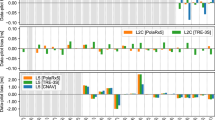Abstract
We provide a comprehensive overview of pseudorange biases and their dependency on receiver front-end bandwidth and correlator design. Differences in the chip shape distortions among GNSS satellites are the cause of individual pseudorange biases. The different biases must be corrected for in a number of applications, such as positioning with mixed signals or PPP with ambiguity resolution. Current state-of-the-art is to split the pseudorange bias into a receiver- and a satellite-dependent part. As soon as different receivers with different front-end bandwidths or correlator designs are involved, the satellite biases differ between the receivers and this separation is no longer practicable. A test with a special receiver firmware, which allows tracking a satellite with a range of different correlator spacings, has been conducted with live signals as well as a signal simulator. In addition, the variability of satellite biases is assessed through zero-baseline tests with different GNSS receivers using live satellite signals. The receivers are operated with different settings for multipath mitigation, and the changes in the satellite-dependent biases depending on the receivers’ configuration are observed.









Similar content being viewed by others
References
Akos DM, Phelts RE, Pullen S, Enge P (2000) Signal quality monitoring: test results. In: Proceedings of the ION NTM 2000, Institute of Navigation, Anaheim, CA, 26–28 January, pp 536–541
Coco DS, Coker C, Dahlke SR, Clynch JR (1991) Variability of GPS satellite differential group delay biases. IEEE Trans Aerosp Elect Syst 27(6):931–938. IEEE. doi:10.1109/7.104264. ISSN 0018-9251
Collins P, Lahaye F, Héroux P, Bisnath S (2008) Precise point positioning with ambiguity resolution using the decoupled clock model. In: Proceedings of the ION GNSS 2008, Institute of Navigation, Savannah, GA, 16–19 September, pp 1315–1322
Edgar C, Czopek F, Barker B (1999) A co-operative anomaly resolution of PRN-19. In: Proceedings of the ION GPS 1999, Institute of Navigation, Nashville, TN, 14–17 September, pp 2269–2268
Geng J, Teferle FN, Meng X, Dodson AH (2011) Towards PPP-RTK: ambiguity resolution in real-time precise point positioning. ASR 47(10):1664–1673. doi:10.1016/j.asr.2010.03.030
Hauschild A, Montenbruck O, Erker S, Thoelert S, Meurer M, Ashjaee J (2011) A multi-technique approach for characterizing the SVN49 signal anomaly—part 1: receiver tracking and IQ constellation. GPS Solutions 16(1):19–28. Springer. doi:10.1007/s10291-011-0203-2. ISSN 1080-5370
Hegarty CJ, Powers ED, Fonville B (2005) Accounting for timing biases between GPS, modernized GPS, and GALILEO signals. In: Proceedings of the ION GNSS 2005, Institute of Navigation, Long Beach, CA, 13–16 September, pp 2401–2407
Jones J, Fenton P, Smith B (2004) Theory and performance of the pulse aperture correlator. http://www.novatel.com/Documents/Papers/PAC.pdf
Laurichesse D, Mercier F, Berthias JP, Broca P, Cerri L (2009) Integer ambiguity resolution on undifferenced GPS phase measurements and its application to PPP and satellite precise orbit determination. Navigation 56(2):135–149. Institute of Navigation
Lestarquit L, Gregoire Y, Thevenon, P (2012) Characterizing the GNSS correlation function using a high gain antenna and long coherent integration—application to signal quality monitoring. In: Proceedings of the IEEE/ION PLANS 2012, Myrtle Beach, SC, 24–26 April, pp 877–885
Lewandowski W, Tourde R (1990) Sensitivity to the external temperature of some GPS timing receivers. In: Proceedings of the PTTI meeting 1990, Vienna, December, 307–316
Mitelman AM, Phelts RE, Akos DM, Pullen SP, Enge PK (2004) Signal deformations on nominally healthy GPS satellites. In: Proceedings of the ION NTM 2004, Institute of Navigation, San Diego, CA, 26–28 January
Phelts RE (2001) Multicorrelator techniques for robust mitigation of threats to GPS signal quality (Doctoral dissertation, Stanford University)
Phelts RE, Akos DM (2006) Effects of signal deformations on modernized GNSS signals. J Global Position Syst 5(1–2):2–10
Phelts RE, Akos DM, Enge P (2000) Robust signal quality monitoring and detection of evil waveforms. In: Proceedings of the ION NTM 2000, Institute of Navigation, Anaheim, CA, 26–28 January, pp 1180–1190
Pini M, Akos D, Esterhuizen S, Mitelman A (2005) Analysis of GNSS signals as observed via a high gain parabolic antenna. In: Proceedings of the ION GNSS 2005, Institute of Navigation, Long Beach, CA, 13–16 September, pp. 1686–1695
Sardón E, Zarraoa N (1997) Estimation of total electron content using GPS data: how stable are the differential satellite and receiver instrumental biases. Radio Sci 32(5):1899–1910. doi:10.1029/97RS01457
Sleewaegen JM, Boom F (2001) Mitigating short-delay multipath: a promising new technique. In: Proceedings of the ION GPS 2001, Institute of Navigation, Salt Lake City, UT, 11–14 September, pp 204–213
Wong G, Phelts RE, Walter T, Enge P (2010) Characterization of signal deformations for GPS and WAAS satellites. In: Proceedings of the ION GNSS 2010, Institute of Navigation, Portland, OR, 21–24 September, pp 3143–3151
Wong G, Phelts RE, Walter T, Enge P (2011) Alternative characterization of analog signal deformation for GNSS-GPS satellites. In: Proceedings of the ION ITM 2011, Institute of Navigation, San Diego, CA, 24–26 January, pp. 497–507
Zhang B, Odijk PJ, Teunissen D (2011) A novel un-differenced PPP-RTK concept. J Navig 64(1):180–191
Acknowledgments
Urs Hugentobler (Technische Universität München) and Peter Steigenberger (DLR/GSOC) are gratefully acknowledged for providing two Triumph-VS receiver for the zero-baseline experiment. Javad GNSS is acknowledged for providing a special SVN49 test firmware for the TRE-G3TH receiver.
Author information
Authors and Affiliations
Corresponding author
Rights and permissions
About this article
Cite this article
Hauschild, A., Montenbruck, O. A study on the dependency of GNSS pseudorange biases on correlator spacing. GPS Solut 20, 159–171 (2016). https://doi.org/10.1007/s10291-014-0426-0
Received:
Accepted:
Published:
Issue Date:
DOI: https://doi.org/10.1007/s10291-014-0426-0




